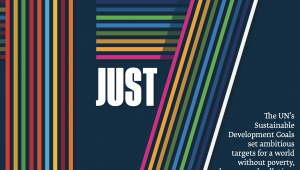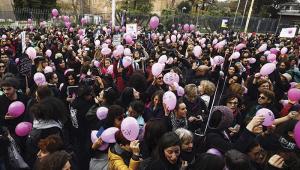Glance over the 17 Sustainable Development Goals and John Lennon’s song Imagine might spring to mind: a vision of a world free from poverty, hunger, disease and conflict, with resources and prosperity enjoyed by all.
It’s easy to be glib, but the SDGs do represent a hugely bold and ambitious agenda for global change.
Adopted in September 2015, the SDGs – also known as the 2030 Agenda – are a universal call to action to end poverty and protect the planet. They cover wellbeing, education and sanitation as well as infrastructure development, economic growth, sustainable cities and gender equality. The agenda even recognises the importance of strong institutions and governance. Each goal is underpinned by a range of indicators to help countries monitor progress.
The UN’s 193 member countries – most of the world’s 196 states – have agreed to work together to achieve these goals by 2030. Then UN secretary general Ban Ki-moon said in New York when the SDGs were adopted: “The new agenda is a promise by leaders to all people everywhere. It is a universal, integrated and transformative vision for a better world.”
Fast forward three years and the world is looking different in many ways. The boy band One Direction, which provided one of many celebrity endorsements at the launch of the SDGs, has sadly split up, but in more important ways we are looking at a changed global context, environmentally and politically.
‘Governance is the foundation upon which everything else is built. If institutions are weak, the odds of SDG success are severely handicapped’
Christine Lagarde, MD of the IMF
Last year was the costliest hurricane season on record, while people across many parts of the world, from Europe to Japan, spent the summer complaining about unprecedented heat levels. Australia was hit with extreme drought, and India faced deadly floods in its southern Kerala state. The south-eastern US has just taken a battering from Hurricane Florence, while the Philippines and southern China are dealing with the devastation caused by Typhoon Mangkhut.
The political sphere has also seen a few unexpected turns. The UK voted to leave the European Union, reality TV tycoon Donald Trump was elected US president with the pledge to “make America great again”, and former sport stars Imran Khan and George Weah were elected to lead the governments in Pakistan and Liberia respectively. There’s been a rise of populism and protectionism, including a trade war with tariffs being thrown from left to right and back again. All of which has contributed to mounting international tensions.
So, three years on, has there been any progress towards making the world a better place? Is the world on track to achieve the 2030 target and are countries still in it together as much as they were in 2015? And does this new political climate threaten success?
 This summer, the UN released its annual report on progress towards the goals. The findings, frankly, were not encouraging. It found that although people are living better lives than a decade ago, “progress to ensure that no one is left behind has not been rapid enough to meet the 2030 agenda”.
This summer, the UN released its annual report on progress towards the goals. The findings, frankly, were not encouraging. It found that although people are living better lives than a decade ago, “progress to ensure that no one is left behind has not been rapid enough to meet the 2030 agenda”.
Hunger is on the rise again, and the number of undernourished people reached 815 million in 2016, up from 777 million in 2015 (Goal 2); men are earning 12.5% more than women in most of the countries where data is available (Goal 5), and pollution is currently killing millions a year (Goal 11), the report warned.
Alongside the report, the UN also ranked and scored member countries on their progress in its 2018 SDG Index. Scandinavian nations Sweden, Denmark and Finland topped the index but still have work to do, particularly on sustainable consumption and climate action.
A lack of data makes it hard to measure the actual progress of the agenda since its inception. According to the OECD, there is no data yet for two-thirds of the indicators set out in the SDGs. Ida Mc Donnell, policy advisor at the OECD, tells PF that only about 0.3% of aid goes to the development of statistical systems. At least $200m per year is still needed for developing countries to collect good data, which will make it easier to measure progress. According to many of the experts that PF spoke to, a lot of the assessments of progress have been based on historic trends and what little data is available.
Countries can choose to present voluntary national reviews at the annual UN High-Level Political Forum on Sustainable Development – last year, 46 countries did this – which allows them to share implementation plans, progress and put the goals into a national context. But Guido Schmidt-Traub, executive director of the UN’s Sustainable Development Solutions Network, says these reviews tend to be more focused on positive developments rather than problems and, although helpful, do not provide a sufficiently clear picture of progress.
Many countries are still struggling to get the basics down and develop a plan of action, experts agree, and measuring progress is simply not on their list yet.
While things might not be on track, we are not at the point of no return – yet.
John McArthur, senior fellow at Brookings Institute, tells PF: “On business as usual, no, the world will not meet its commitments, that seems pretty clear. So, the question is, where can you change business as usual?”
A major problem is the lack of funding for countries that do not have the resources to finance delivery of the goals – or the capacity and knowledge to make fundamental changes.
World leaders met in Addis Ababa just months before the SDGs were adopted to address the financing of the development “in the spirit of global partnership and solidarity”. But Marcus Manuel, senior research associate at the Overseas Development Institute, suggests global financing trends are shifting in the wrong direction. “We are not making good progress. We have known for a while which countries need financial support and we are, if anything, moving away from supporting them.”
There are different figures floating around on how much achieving the SDGs will cost. Some say $3trn a year, while others put it closer to $7trn. Whatever the amount, McArthur says, “the world is not spending enough to take care of the poorest people on the planet and their basic needs”.
Pedro Conceição, director for strategic policy at the United Nations Development Programme, tells PF that putting a price tag on the agenda could make people think money is the only thing that matters. “Attempts to measure financing gaps for the SDGs as a whole may be misleading. It’s more difficult to come up with a number for the entire agenda – it might give the wrong impression that all we need to do is mobilise those resources.”
But low- and middle-income and developing countries do need more money and to raise their own revenue, such as taxes, to fund the development agenda. Experts say that both public and private investments need to be aligned with the goals in one way or another, including incentives to attract the private sector to invest sustainably.
At the ODI, Manuel says: “Whatever precise definitions [of aid and financing] you are using, the bottom line is that the money that we need to get to the poorest countries is not getting there in the volumes that it needs to.”
ODI research published in September found that although there has been some progress towards eliminating poverty – the first and arguably most important of the 17 SDGs – 48 countries would still struggle to cover the costs of health, education and social protection, even if they maximised their tax intake. Of these, 29 countries, including the Central African Republic, Niger, Mali and Senegal, are so financially challenged that they would not even be able to cover half the costs, Manuel adds.
He explains that these countries face a $150bn financing gap for these three areas, which are crucial to ending extreme poverty. “At the moment, aid is only filling one-sixth of that – only $25bn. Financing isn’t everything, but there are some things that you just can’t do without the money – no matter how brilliant you are,” he says, adding that every donor must get to giving 0.7% of gross national income in aid to help eliminate extreme poverty.
If aid isn’t targeted and focused on reducing poverty, at least 400 million people will still be living on less than $1.90 a day by 2030 – the globally recognised poverty line, the ODI research claims.
While funding is vital, countries also need to ensure they prepare for how to achieve the goals. Schmidt-Traub tells PF: “Countries need a plan – and very quickly if they don’t have one already. They need to have a sense of what they are actually going to do. Many countries just don’t have a clear sense of what needs to be done.”
Significantly, the UN and other international partners recognise the importance of strong institutions and good governance to delivery of the SDGs. During her September visit to London, Christine Lagarde, head of the International Monetary Fund, said: “Governance is the foundation upon which everything else is built. If institutions are weak, the odds of SDG success are severely handicapped.”
Good governance is important for institutions across the board, private and public sector, domestically and internationally, she added.
McArthur agrees. “There is no question that institutions are crucial,” he explains. “We have to be very specific in thinking through the different aspects of institutions – it’s about the delivery of services, whether health, education, justice or something else. I think we need to focus not just on the shape of the Lego tower but the components of it. The pieces that go into each strong institution are crucial.”
Vivi Niemenmaa, auditor at the European Court of Auditors and seconded national expert from the Finnish national audit office, adds: “Good governance is key, and transparency and participation are therefore preconditioning for implementing SDGs. Governments cannot achieve sustainable development goals by themselves, but they need to involve all government sectors and also all stakeholders and work together.”
This is what Goal 16: Peace, Justice and Strong Institutions aims to achieve. It calls for a reduction in violence, the promotion of the rule of law, combating corruption and crime, as well as developing strong, accountable and transparent institutions. The UN indicators to measure the goals and targets include looking at “primary government expenditure as a proportion of original approved budget, by sector” and people’s satisfaction with public services.
But measuring the progress of Goal 16, even taking the indicators into account, can be a challenge. Peter Welch, director of sustainable use of natural resources at the European Court of Auditors, suggests using the CIPFA-IFAC framework for good governance, which “is a good starting point and the nearest thing to a global standard”. The OECD has also set up a network to look at governance around the world and offer support to countries that need it.
The International Organization of Supreme Audit Institutions has set out guidelines on how to audit the progress of all the goals, including government programmes and structures (see panel).
Niemenmaa explains that audit institutions around the world have conducted audits on SDG preparedness and found that there are weaknesses in government structures, missing national strategies or implementation plans, a lack of transparency and, again, problems with data and financing.
The weather in the past year has been the centre of much discussion this summer and sparked concern about the climate. Welch says: “If I had to pick one SDG that is particularly important, it is SDG 13. It is very hard to see how we achieve long-term sustainability without action on climate change.”
Most G20 countries have shown good progress on climate action (Goal 13), committing to the Paris Agreement and implementing policies to match. As of April this year, 175 countries had ratified the Paris Agreement. Recent weather has also put climate action in the spotlight, with heatwaves and drought hitting the livelihoods of farmers in Australia in particular, and the heavy rainy season across India resulting in deadly floods.
Schmidt-Traub adds: “People really understand that the climate is changing, but now we need to decide what to do about it. We need more work and more political leadership on this.”
But world leaders tend to disagree on some things – including climate change. President Trump has threatened to undermine climate progress by withdrawing from the Paris Agreement. Given recent political events, it seems countries are pulling back on international collaboration.
McArthur explains: “There’s no question that international cooperation in much, but not all, of the world at the highest levels of multilateralism has been strained in the past couple of years.” But countries still “want the same thing”, he adds.
At the OECD, Mc Donnell observes that the problems the agreement aims to address are historical ones. “These are not new priorities that came out of the blue that no one was working on before 2015.”
And though it is clear that there is some fresh international tension, Schmidt-Traub says it is important to focus on what really matters. “We are using too much of our mind space following silly tweets. I think we should be thinking hard about how to solve these problems. We don’t have enough of a discussion on how to decarbonise energy systems, for example, even though it’s an existential question for humanity and climate change.”
 World leaders are meeting next year in New York to follow up on the progress of the goals, although Lagarde has warned: “If implementing the SDGs is a race, it is increasingly an uphill one.”
World leaders are meeting next year in New York to follow up on the progress of the goals, although Lagarde has warned: “If implementing the SDGs is a race, it is increasingly an uphill one.”
But it’s not too late. McArthur says estimates of progress are not meant to be predictions of the outcome but to help pinpoint where the problems are. He adds that the meeting next year is “the most seminal moment for the world to change business as usual”.
“If everyone doesn’t take it seriously, then we don’t change the course of history. All of us need to think about how we make 2019 and 2020 [the climate summit] as impactful as possible to make a change.”
Until then, we can keep imagining a world free from hunger and poverty – and perhaps next year we will see if we are any closer to Lennon’s vision or drifting further away.
INTOSAI GUIDELINES
Four for thought
Audit institutions play a big role in the implementation and monitoring of the SDGs. The International Organization of Supreme Audit Institutions has issued four approaches to auditing the SDGs. These are:
Assessing the preparedness of national governments to implement the SDGs
Undertaking performance audits in the context of the SDGs
Contributing to the implementation of SDG 16, which envisages effective, accountable and transparent institutions
Possibilities for SAIs to act as models of transparency and accountability in their own operations.
Since 2016, more than 100 member institutions have shown interest in SDG-related audits.
The European Court of Auditors has reviewed climate and energy policy in the bloc and audited air quality and nature protection.














